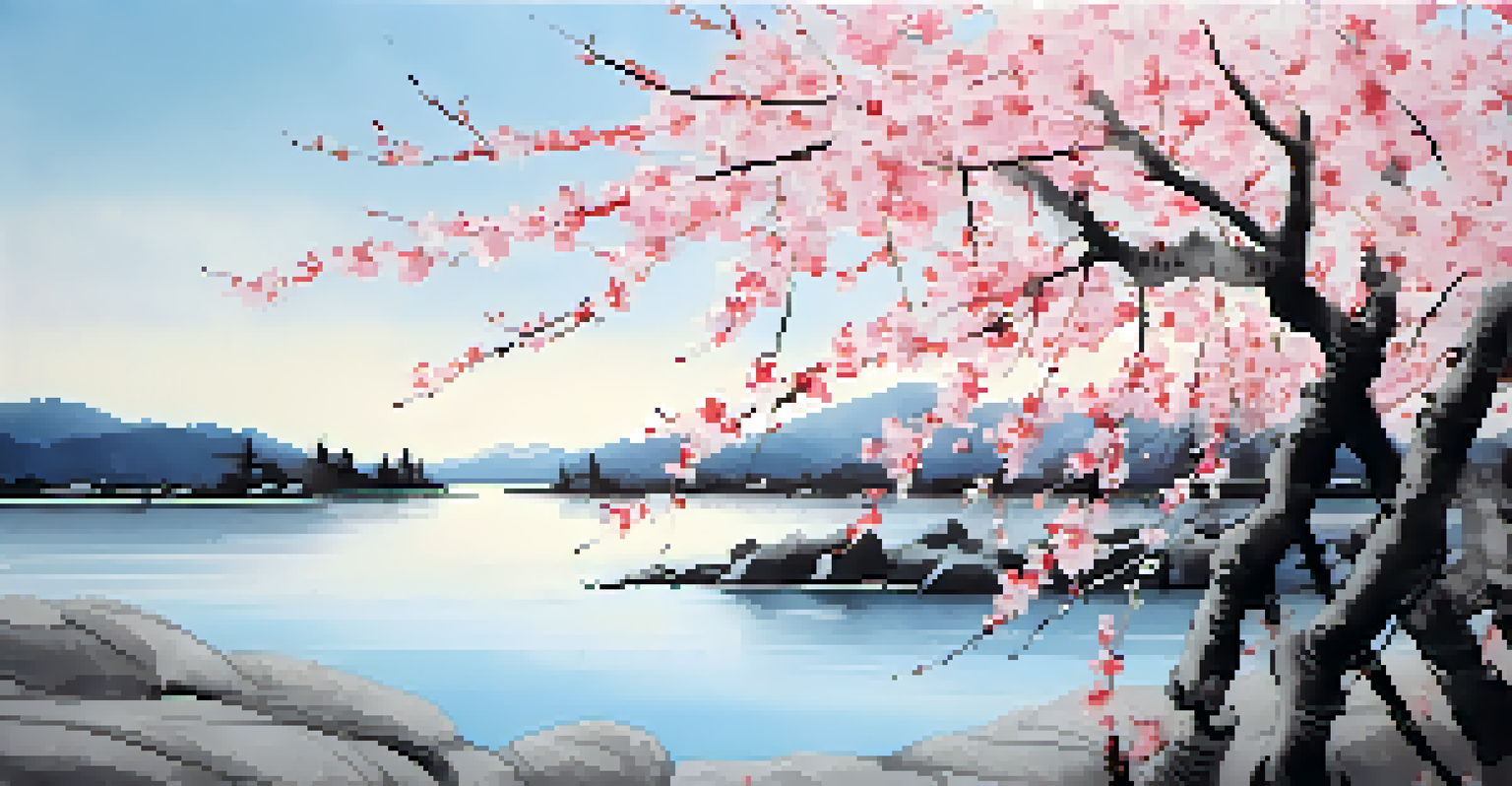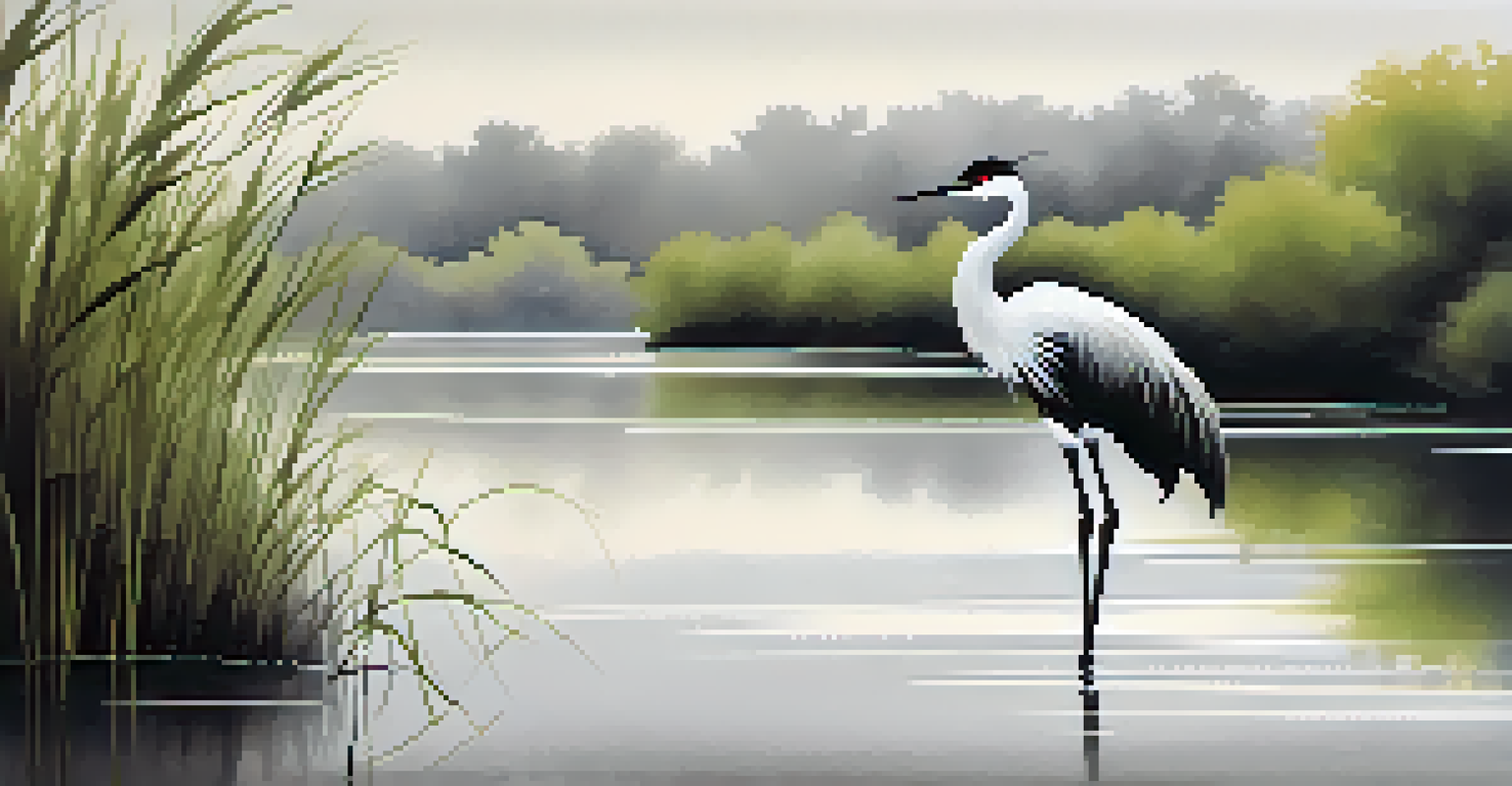Japanese Sumi-e: The Art of Simplicity and Nature's Essence

Understanding Sumi-e: A Traditional Japanese Art Form
Sumi-e, or ink wash painting, is a traditional Japanese art form that emphasizes simplicity and the beauty of nature. Originating from China, it was adapted in Japan, where it flourished and developed its own unique style. Unlike Western painting, Sumi-e uses black ink and focuses on capturing the essence of a subject rather than detailed realism. This method encourages artists to express their feelings and thoughts through a few deliberate brushstrokes.
Art enables us to find ourselves and lose ourselves at the same time.
The philosophy behind Sumi-e is deeply rooted in Zen Buddhism, which values mindfulness, simplicity, and harmony with nature. Each stroke of the brush is intentional and reflects the artist’s state of mind, making the practice as much about the journey as the final piece. This meditative aspect offers artists a chance to connect with their inner selves while creating something beautiful.
As you delve into Sumi-e, you’ll find that it’s not just about painting; it’s about cultivating a mindset that appreciates the world’s natural beauty. The art form invites you to slow down, observe your surroundings, and find beauty in the mundane. This approach can transform your everyday experiences and deepen your appreciation for nature.
The Tools of Sumi-e: Essential Equipment for Beginners
To start your journey in Sumi-e, you'll need a few essential tools: rice paper, Sumi ink, and brushes. Rice paper is known for its absorbent quality, allowing the ink to flow beautifully across its surface. Sumi ink, traditionally made from soot and animal glue, comes in ink sticks that you grind against an ink stone to create a rich, dark liquid. Brushes vary in size and type, each designed to produce different brush strokes and effects.

The unique brushes used in Sumi-e are typically made from animal hair, which allows for both fine details and broad strokes. These brushes are not just tools; they are extensions of the artist’s hand, enabling a range of expressions. The importance of mastering brush techniques cannot be overstated, as they can drastically affect the outcome of your artwork.
Sumi-e: Embracing Simplicity
Sumi-e art emphasizes the beauty of nature and simplicity, allowing artists to express their feelings through intentional brushstrokes.
It's important to note that while the tools may seem simple, the skill lies in how they are used. Beginners may feel overwhelmed at first, but with practice, the movements become more fluid. Each tool plays a role in embodying the philosophy of Sumi-e, where simplicity in equipment leads to profound expression.
The Philosophy Behind Sumi-e: Embracing Imperfection
At the heart of Sumi-e is a philosophy that embraces imperfection and the natural flow of life. This concept, known as 'wabi-sabi,' celebrates the beauty found in simplicity and transience. In Sumi-e, every brushstroke is valuable, even those that may seem imperfect or unplanned. This approach encourages artists to let go of the need for perfection and to appreciate the beauty of each unique creation.
Simplicity is the ultimate sophistication.
Embracing imperfection allows artists to express their emotions freely without the constraints of traditional standards. This mindset can be liberating, as it encourages creativity and self-discovery. When you paint in this style, you're not just creating art; you're engaging in a dialogue with your inner self and the world around you.
Additionally, this philosophy fosters a deep connection to nature, as artists often depict natural elements like mountains, rivers, and flora. These subjects remind us of life's fleeting moments and the importance of appreciating the present. By allowing imperfections into your work, you cultivate a deeper understanding of both art and life.
Sumi-e Techniques: Capturing Nature's Essence
Sumi-e techniques focus on the use of brush strokes to convey the essence of a subject rather than its intricate details. One common technique is called 'suiboku' which means ‘ink and white’, emphasizing the contrast between black ink and the blank paper. This technique captures the essence of landscapes, flowers, and animals in a minimalist way, allowing the viewer’s imagination to fill in the gaps.
Another important technique is 'kakejiku', which involves painting on hanging scrolls, often used in traditional Japanese settings. This method adds a dynamic element to the artwork, allowing it to be displayed and appreciated in various contexts. The scrolls often feature calligraphy alongside the paintings, integrating text and image harmoniously.
Tools Essential for Beginners
To start practicing Sumi-e, essential tools like rice paper, Sumi ink, and specialized brushes are needed to create fluid and expressive artwork.
Practicing these techniques requires patience and a willingness to experiment. As you learn to manipulate your brush and ink, you'll find that each stroke tells a story. The more you practice, the more intuitive your movements become, allowing you to express the beauty of nature in your own unique style.
Famous Sumi-e Artists: Inspirations from History
Throughout history, several artists have made significant contributions to the world of Sumi-e, inspiring countless others. One notable figure is Sesshū Tōyō, a 15th-century master known for his stunning landscapes and deep understanding of light and shadow. His works often evoke a sense of tranquility and harmony, capturing the essence of the natural world.
Another influential artist is Yokoyama Taikan, who helped bridge traditional Sumi-e and modern Japanese painting. His innovative approach incorporated Western techniques while maintaining the spirit of Sumi-e, creating a unique fusion that resonated with many. Taikan's legacy continues to inspire contemporary artists to explore and adapt the art form.
These artists remind us that Sumi-e is not just a technique but a way of seeing the world. Their works encourage us to appreciate simplicity and to find beauty in our surroundings. By studying their lives and creations, aspiring Sumi-e artists can gain insights into their own artistic journeys and the philosophies that underpin this beautiful art form.
Modern Interpretations of Sumi-e: A Contemporary Twist
In recent years, Sumi-e has seen a resurgence in popularity, with contemporary artists adding their unique interpretations to this traditional art form. Many artists are experimenting with color, incorporating vibrant hues while still paying homage to the essence of Sumi-e. This blending of styles showcases the adaptability of the art form, demonstrating that it can evolve while retaining its core principles.
Modern Sumi-e artists often explore new themes, including urban landscapes and abstract concepts. By pushing the boundaries of traditional techniques, they are able to connect with a broader audience and inspire new generations of artists. This evolution reflects the dynamic nature of art, where tradition meets innovation.
Philosophy of Imperfection
The Sumi-e philosophy celebrates imperfection and the natural flow of life, encouraging artists to appreciate unique creations and connect with nature.
Furthermore, workshops and online classes have made Sumi-e more accessible, encouraging people around the world to try their hand at this beautiful practice. As more individuals discover Sumi-e, the art form continues to grow and thrive, proving that simplicity and nature's essence are timeless themes that resonate across cultures and generations.
Getting Started with Sumi-e: Tips for Beginners
If you’re eager to explore the world of Sumi-e, starting with the right mindset is essential. Approach your practice with an open heart and a willingness to embrace mistakes as part of the learning process. Remember, Sumi-e is less about achieving perfection and more about expressing your unique perspective and emotions through art.
Begin by familiarizing yourself with the tools and techniques mentioned earlier. Practice basic brush strokes on scrap paper to build your confidence. As you become more comfortable, try painting simple subjects like bamboo or cherry blossoms, which are often depicted in Sumi-e for their beauty and symbolism.

Lastly, consider joining a local class or online community where you can learn from experienced artists and share your progress. Engaging with others can provide valuable feedback and encouragement, making your Sumi-e journey even more rewarding. With patience and practice, you’ll discover the joy of capturing nature’s essence through this beautiful art form.